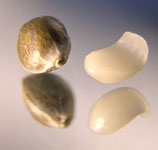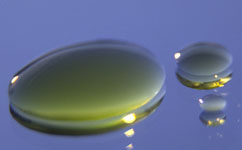Hemp seed belongs without doubt, to one of the most nutritionally valuable oleiferous fruit. For thousands of years, hemp was used for human nourishment. Into the 19th century, hemp was a well known and well appreciated plant oil.
Since the middle of the 90ties, hemp has celebrated ist comeback as a regrowable natural resource and deliverer of high quality fibres and seed. Only in recent years, science was able to discover hemp and prophesy hemp’s great future as a seed and oil producing plant. What makes hemp seed and hemp oil so valuable? Hemp oil is especially rich in polyunsaturated fatty acids (approx. 90%) , vital for the human organism. Here to be specially noted, is that in edible oils, essential fatty acids linoleic acid (50-70%) and alpha linoleic acid (15-25 %) ; particularly omega-3 fatty acids alpha linoleic acids are rarely present in such large proportions. A very balanced composition of fatty acids makes hemp oil generally one the most valuable edible oils. The experts for fats Dr. Ulrich Strunz and Andreas Jopp wrote in their actuall book “Fit With Fat” – “… for the correct balance of tissue homones it is necessary that omega-6 and omega-3 fats be applied in ratio 3:1. However, we receive 20 times more omega-6 fats…The ratio of omega-6 to omega-3 in hemp oil is 3:1. Because of that, hemp oil belongs to the top omega-3 deliverers.” (Strunz & Jopp 2002)
15 to 20 gramm of hemp oil is sufficient to meet the daily human nutrition requirements in essential fatty acids completely. If made part of daily nourishment, hemp oil protects us from a variety of metabolic, arteriosclerotic, vascular and cardiovascular illnesses, that are, according to a recent survey, partially ascribed to excessively high fraction of saturated and trans-saturated fatty acids in food.
With these ingredients, hemp seed and hemp oil not only represent specially valuable nutrition – but there are also a variety of therapeutical applications. Alpha linoleic-acid has, together with omega-3 fatty acid a comparable effect to fish oils and can therefore be applied by cardiovascular illnesses and chronic inflammation, therapeutically. A further composite earns special attention as therapeutic agent. Hemp belongs to the few oleiferous plants whose seeds contain (2-4%) gamma-linoleic acid (GLA). In the human body, a gamma-linoleic acid deficiency can lead to serious metabolic illnesses. In such cases, if gamma-linoleic acid is applied, various states of these illnesses can be influenced positively. Belonging to these states are, neurodermititis, premenstrual syndrome, rheumatic arthritis and diabetic neuropathy – only to name of few of the most important areas.
 Hemp seed
Hemp seed From a botanical perspective, the fruit of the hemp plant is a nut (mini nut), that is surrounded by a thin, glassy, fruit husk. The nutrient-rich seed are coloured brown to black-grey, sometimes even coloured green-grey. Hemp seed have a diameter of approx. 3-4 mm. and a thousand-seed weight of 5-20 g.
Eight of the altogether 21 aminoacids can not be produced by the human body. They must be applied from external sources, so that the human organism can build body proteins in sufficient quantities. These eight aminoacids are therefore termed – essential aminoacids.
Hemp protein contains all eight essential aminoacids and is therefore totally valuable. The main component is the globulin edestin, that is even easier to digest as soy protein. Therefore, hemp seed provides a good protein source for humans; out of which the human body can produce all vital proteins. Because of its similarity with our blood plasma’s globular proteins, the organism can e.g. easily produce immunoglobines, that play a most important role in resisting infections.
 Hemp oil
Hemp oilIn order to produce valuable hemp seed oil out of equally valuable hemp seed, a careful harvest and cautious pressing is necessary. The seed is enclosed by a firm shell, that protects it’s contents from enviromental influence, especially from oxygen and light. To produce oil, the seed has to be pressed until oil emits. Here, it’s especially necessary to handle with care. During pressing, warmth is produced, in which case, by too much temperature, the protein and fats would be chemically altered adversely.
For this reason, when producing edible oil, the cold pressing process is applied, in which the temperature is not allowed to exceed 40 °. Due to the caring cold pressing and air-tight filling in dark bottles, the valuable fatty acids, as well as the natural “nutty” flavour of the oil, is preserved.
Hemp oil is excellent for cooking, not only because of its special taste but also because of it’s richness in vital fatty acids.
Because of it’s spectrum of fatty acids, hemp belongs nutritionally to the top ranking plant oils and should replace the usual oils in cooking, as far as possible, or at least be combined with them. As the smoke point of unrefined, edible hemp oil already starts at 165 ° , it should not be used for frying or french-frying because in these procedures, temperatures exceeding 165 ° are produced. In that case fatty acids are destroyed and hemp oil’s taste is adversely affected.
Hemp oil is suitable for steaming or stewing as long as the presence of water at high temperatures is avoided. Appart from that, it can be used for salad dressings, bread spreads, marinades and dips. The most important fatty acids for humans and mammals are linoleic-acid, that is a 2 times unsaturated omega-6 fatty acid. It is present in numerous plant oils and is present in hemp oil, in a concentration over 50 %. According to the recommendation from the German Society for Nutrition (Deutsche Gesellschaft für Ernährung 1991) the daily adult requirement for linoleic-acid is about 7 g., whereas an amount of 10 g. is recommended. That would be an equivalent of 50-60 hemp seeds or 15-20 g. hemp oil daily.

The oils contained in the hemp seed are regarded as the most valuable edible oil generally. “Due to its extraordinarily well balanced fatty-acid profile, one could live a life time on hemp oil/hemp seed without contracting any deficiency of essential fatty acids (EFA). The 3 % content of gamma-linoleic fatty acid (GLA) makes it most unique amongst edible oils.” and “The compositon of fatty acids in our nutrition has changed within this century. Oils with a low fatty acid content became standard in groceries. We buy oils, that have been altered by being exposed to heat and chemicals. Unfortunately, their natural nutrients are transformed in whole or part into harmful substances: e.g. trans fatty acids, polymers and other materials. Through hydrogenation – used since the 30ties in large scale to produce margarines and backing fats – many altered fat substances arrive in our food. Refined food products “white” oils and “white” fats are nutritionally comparable to refined sugar and white flour; they are protein free, de-mineralised, de-vitaminised and free of dietary fibre. They can not be matabolised properly, and withdraw both minerals and vitamines from the body. Over a longer time, this leads to deficieny symtoms.
Source: „Fats That Heal, Fats That Kill.“ Vancouver 1993 from Udo Erasmus. Nuritional Scientist.
Texts were compiled in cooperation with www.nova-institut.de (Authors: D. Kruse / M. Karus)
No comments:
Post a Comment